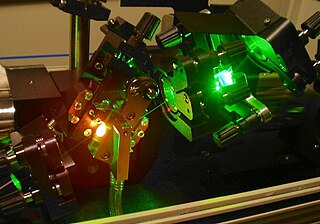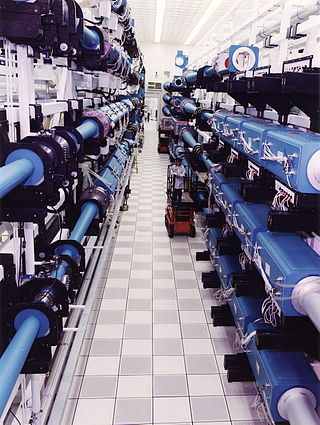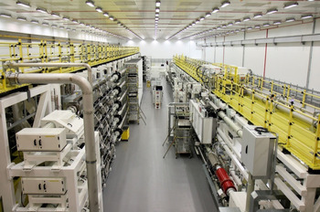
The National Ignition Facility (NIF) is a laser-based inertial confinement fusion (ICF) research device, located at Lawrence Livermore National Laboratory in Livermore, California, United States. NIF's mission is to achieve fusion ignition with high energy gain. It achieved the first instance of scientific breakeven controlled fusion in an experiment on December 5, 2022, with an energy gain factor of 1.5. It supports nuclear weapon maintenance and design by studying the behavior of matter under the conditions found within nuclear explosions.

Titanium-sapphire lasers (also known as Ti:sapphire lasers, Ti:Al2O3 lasers or Ti:sapphs) are tunable lasers which emit red and near-infrared light in the range from 650 to 1100 nanometers. These lasers are mainly used in scientific research because of their tunability and their ability to generate ultrashort pulses thanks to its broad light emission spectrum. Lasers based on Ti:sapphire were first constructed and invented in June 1982 by Peter Moulton at the MIT Lincoln Laboratory.

In optics, the Pockels effect, or Pockels electro-optic effect, is a directionally-dependent linear variation in the refractive index of an optical medium that occurs in response to the application of an electric field. It is named after the German physicist Friedrich Carl Alwin Pockels, who studied the effect in 1893. The non-linear counterpart, the Kerr effect, causes changes in the refractive index at a rate proportional to the square of the applied electric field. In optical media, the Pockels effect causes changes in birefringence that vary in proportion to the strength of the applied electric field.
The Laboratory for Laser Energetics (LLE) is a scientific research facility which is part of the University of Rochester's south campus, located in Brighton, New York. The lab was established in 1970 with operations jointly funded by the United States Department of Energy, the University of Rochester and the New York State government. The Laser Lab was commissioned to investigate high-energy physics involving the interaction of extremely intense laser radiation with matter. Scientific experiments at the facility emphasize inertial confinement, direct drive, laser-induced fusion, fundamental plasma physics and astrophysics using the OMEGA Laser Facility. In June 1995, OMEGA became the world's highest-energy ultraviolet laser. The lab shares its building with the Center for Optoelectronics and Imaging and the Center for Optics Manufacturing. The Robert L. Sproull Center for Ultra High Intensity Laser Research was opened in 2005 and houses the OMEGA EP laser, which was completed in May 2008.

An optical parametric amplifier, abbreviated OPA, is a laser light source that emits light of variable wavelengths by an optical parametric amplification process. It is essentially the same as an optical parametric oscillator, but without the optical cavity.
Chirped pulse amplification (CPA) is a technique for amplifying an ultrashort laser pulse up to the petawatt level, with the laser pulse being stretched out temporally and spectrally, then amplified, and then compressed again. The stretching and compression uses devices that ensure that the different color components of the pulse travel different distances.

The Shiva laser was a powerful 20-beam infrared neodymium glass laser built at Lawrence Livermore National Laboratory in 1977 for the study of inertial confinement fusion (ICF) and long-scale-length laser-plasma interactions. Presumably, the device was named after the multi-armed form of the Hindu god Shiva, due to the laser's multi-beamed structure. Shiva was instrumental in demonstrating a particular problem in compressing targets with lasers, leading to a major new device being constructed to address these problems, the Nova laser.

Nova was a high-power laser built at the Lawrence Livermore National Laboratory (LLNL) in California, United States, in 1984 which conducted advanced inertial confinement fusion (ICF) experiments until its dismantling in 1999. Nova was the first ICF experiment built with the intention of reaching "ignition", a chain reaction of nuclear fusion that releases a large amount of energy. Although Nova failed in this goal, the data it generated clearly defined the problem as being mostly a result of Rayleigh–Taylor instability, leading to the design of the National Ignition Facility, Nova's successor. Nova also generated considerable amounts of data on high-density matter physics, regardless of the lack of ignition, which is useful both in fusion power and nuclear weapons research.
Laser Mégajoule (LMJ) is a large laser-based inertial confinement fusion (ICF) research device near Bordeaux, France, built by the French nuclear science directorate, Commissariat à l'Énergie Atomique (CEA).

Argus was a two-beam high power infrared neodymium doped silica glass laser with a 20 cm (7.9 in) output aperture built at Lawrence Livermore National Laboratory in 1976 for the study of inertial confinement fusion. Argus advanced the study of laser-target interaction and paved the way for the construction of its successor, the 20 beam Shiva laser.
The Gekko XII Laser (激光XII号レーザー) is a high-power, 12-beam, neodymium-doped glass laser at the Osaka University's Institute for Laser Engineering (大阪大学レーザーエネルギー学研究センター) completed in 1983, which is used for high energy density physics and inertial confinement fusion research. The name refers to the twelve individual beamlines used to amplify the laser energy.

The High Power laser Energy Research facility (HiPER), is a proposed experimental laser-driven inertial confinement fusion (ICF) device undergoing preliminary design for possible construction in the European Union. As of 2019, the effort appears to be inactive.
LULI : Laboratoire pour l'Utilisation des Lasers Intenses (LULI) is a scientific research laboratory specialised in the study of plasmas generated by laser-matter interaction at high intensities and their applications. The main missions of LULI include: (i) Research in Plasma Physics, (ii) Development and operation of high-power high-energy lasers and experimental facilities, (iii) student formation in Plasma Physics, Optics and Laser Physics.

The Trident Laser was a high power, sub-petawatt class, solid-state laser facility located at Los Alamos National Laboratory, in Los Alamos, New Mexico, originally built in the late 1980s for Inertial confinement fusion (ICF) research by KMS Fusion, founded by Kip Siegel, in Ann Arbor, Michigan, it was later moved to Los Alamos in the early 1990s to be used in ICF and materials research. The Trident Laser has been decommissioned, with final experiments in 2017, and is now in storage at the University of Texas at Austin.

The Extreme Light Infrastructure is a research organization with the world's largest collection of high power-lasers. ELI operates several high-power, high-repetition-rate laser systems which enable the research of physical, chemical, materials, and medical sciences.
Central Laser Facility (CLF) is a research facility in the UK. It is part of the Rutherford Appleton Laboratory. The facility is dedicated to studying the applications of high energy lasers. It was opened in 1976. As of 2013 there are 5 active laser laboratories at the CLF: Vulcan, Astra Gemini, Artemis, ULTRA, and OCTOPUS. The facility provides both high-power and high-sensitivity lasers for study across broad fields of science from atomic and plasma physics to medical diagnostics, biochemistry and environmental science. Also through the Centre for Advanced Laser Technology and Application (CALTA), CLF is responsible for laser development. DiPOLE is the brainchild of that project.

The Orion Laser Facility is a high power laser facility based at the Atomic Weapons Establishment (AWE) on the former RAF Aldermaston site in the United Kingdom.

Donna Theo Strickland is a Canadian optical physicist and pioneer in the field of pulsed lasers. She was awarded the Nobel Prize in Physics in 2018, together with Gérard Mourou, for the practical implementation of chirped pulse amplification. She is a professor at the University of Waterloo in Ontario, Canada.












